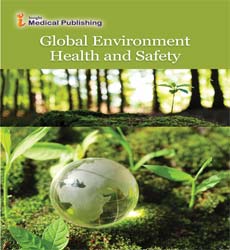Pollution and Ecology
Pan Lu*
Department of Transportation Engineering, Southeast University, Angola
- *Corresponding Author:
- Pan Lu
Department of Transportation Engineering, Southeast University, Angola
Tel: 5764529809
E-mail: pan123@yahoo.com
Received Date: July 23, 2021; Accepted Date: October 13, 2021; Published Date: October 23, 2021
Citation: Pan Lu (2021) Pollution and ecology. J Glob Environ Health Saf. Vol: 5 No: 1.
Introduction
One of our era's greatest scourges is air pollution, on account not only of its impact on climate change but also its impact on public and individual health due to increasing morbidity and mortality. There are many pollutants that are major factors in disease in humans. Among them, particulate (PM), particles of variable but very small diameter, penetrate the system respiratory via inhalation, causing respiratory and cardiovascular diseases, reproductive and central system nervous dysfunctions, and cancer. Despite the very fact that ozone within the stratosphere plays a protective role against ultraviolet irradiation, it's harmful when in high concentration at ground level, also affecting the respiratory and cardiovascular system. Furthermore, oxide , sulphur dioxide , Volatile Organic Compounds (VOCs), dioxins, and polycyclic aromatic hydrocarbons (PAHs) are all considered air pollutants that are harmful to humans. Carbon monoxide can even provoke direct poisoning when breathed in at high levels. Heavy metals like lead, when absorbed into the physical body , can cause direct poisoning or chronic intoxication, counting on exposure. Diseases occurring from the aforementioned substances include principally respiratory problems like Chronic Obstructive Pulmonary Disease (COPD), asthma, bronchiolitis, and also carcinoma , cardiovascular events, central system nervous dysfunctions, and cutaneous diseases. Last but not least, climate change resulting from environmental pollution affects the geographical distribution of many infectious diseases, as do natural disasters. The only thanks to tackle this problem is thru public awareness including a multidisciplinary approach by scientific experts; national and international organizations must address the emergence of this threat and propose sustainable solutions.
The different types of pollution are as follows
Air Pollution
it's the contamination of the natural air by mixing it with different pollutants like harmful fumes and chemicals. This type of contamination are often caused by burning material or by gases emitted by vehicles or harmful fumes emitted as a by-product of industries. Global warming is one among the most important side effects of pollution as per the experts.
Water Pollution
it's the contamination of the water on the earth. It includes water contamination by pollutants like bacterial, chemical, and particulate that reduces the purity of the water. Oil seepage, also as littering is one among the foremost common sorts of pollution. It mainly occurs in lakes, oceans, rivers and even underground reservoirs.
Soil Pollution
It is also known as land pollution. It is the contamination of the soil or the land that prevents the growth of natural life. It includes land usage for irrigation, wildlife also as habitation. The quite common causes of soil pollution include hazardous wastage, mining also as littering, non-sustainable farming practice, seepage into the soil, etc.
Noise Pollution
it's the loud noises which are fashioned by human activities that disturb the quality of living within the affected area. It can shoot from things like railroads, traffic, loud music, concerts, aeroplanes, fireworks etc. This can even end in permanent or temporary loss of hearing also as disturbances to wildlife.
Radioactive Pollution
This is one of the most dangerous forms of pollution. It is enormously harmful and may even end in death. We are witting this sort of pollution from the 20th century. It evolved with the increase of nuclear physics and nuclear weapons. Radioactive pollution results in the pollution of the air and land with radioactive poisoning. Leakages or accidents at atomic power plants, also as from improper disposal of nuclear waste also are reasons for this pollution. This pollution results in birth defects, cancer, deteriorating of health and even death.
Conclusion
Thus, somewhere we will understand that each one sorts of pollutions are interrelated and indirectly are often a cause for every other. As pollution features a direct reference to pollution . Light pollution is caused by energy companies that need burning fossil fuels. In return, they increase air pollution and it increases water pollution.
As one can see, there is a connexion between all the types connexion between all the types of pollution. To fight the pollution, it'd appear to be a daunting task for one person, but even doing a touch bit sometimes helps. In fact, reduction in water wastage, consuming less light or even not littering can result in reducing pollution massively. even doing a touch bit sometimes helps. In fact, reduction in water wastage, consuming less light or even not littering can result in reducing pollution massively.
Open Access Journals
- Aquaculture & Veterinary Science
- Chemistry & Chemical Sciences
- Clinical Sciences
- Engineering
- General Science
- Genetics & Molecular Biology
- Health Care & Nursing
- Immunology & Microbiology
- Materials Science
- Mathematics & Physics
- Medical Sciences
- Neurology & Psychiatry
- Oncology & Cancer Science
- Pharmaceutical Sciences
